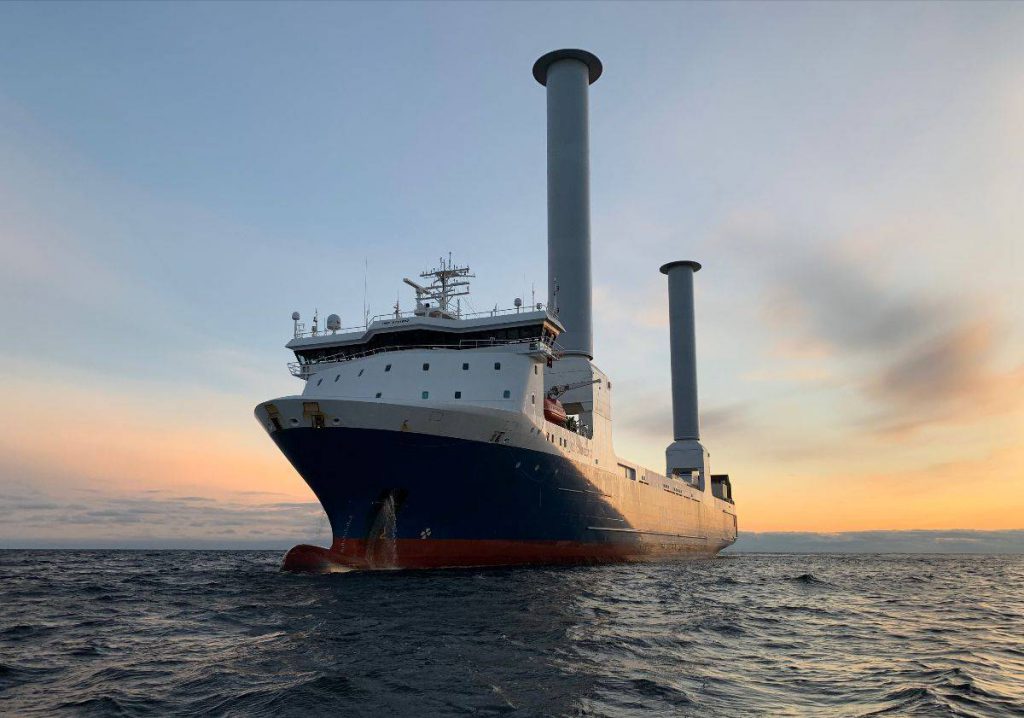The humble sail has evolved into a truly green technology for a sustainable maritime industry
by Penny Thomas
Shipping’s decarbonisation drive has seen the industry look to alternative options and cutting-edge technologies to save fuel and ultimately the planet. It’s ironic that in the midst of research on vessel routing, new fuel types and friction-reducing technologies, amongst others, the industry is also looking to millennial-old practices in its effort to reduce emissions.
Historians’ perspective on when man first ‘set sail’ differ slightly but broadly speaking it was around 4000 BC. The ‘age of sail’, a period when sophisticated sailing vessels such as clippers, cutters and schooners reigned supreme, reinventing global trade routes, winning and losing battles and opening up the world (whether for good or bad), enjoyed a 300 to a 400-year long history. It began around the mid-15th to 16th century and finally succumbed to the steamship in the mid-1900s.
For thousands of years, humans used the power of wind – a free, zero carbon, totally sustainable form of energy – to their advantage, and the shipping industry is turning its attention to it once again. Modern wind-powered solutions, however, bear a little physical resemblance to the sailing rigs of yesteryear.
Rotors, turbines, hand sails and kites, are amongst the wind-powered solutions for ships that have been presented as feasible emissions-reducing solutions.
The International Windship Association (ISWA) told MarineTraffic that there are currently 17 large vessels with wind systems installed, and one further wind-ready vessel. The association’s secretary-general Gavin Allwright said that he expects there to be 20 vessels with wind systems sailing by the end of Q1 2022. He noted that whilst some installations are delayed due to components tied up in the logistics slowdown, he expects to see double the installations on large vessels (around 40) by Q1/2 2023.
Most recently an automated kite installation was completed on ro-ro vessel Ville de Bordeaux, with trials commencing in 2022, it was announced in December. The Louis Dreyfus Armateurs-operated vessel that makes trans-Atlantic crossings between Europe and the US carrying aircraft components, is trialling an automated kite from wind-propulsion company Airseas. Japanese shipowner K Line has already made a commitment to the technology and in July 2021, following trials in 2018, it was announced that an Airseas kite would be installed on an LNG powered newbuild bulker.
It’s a compelling story for an industry looking to shave off emissions, and costs, in as many ways as possible.
In 2018, Maersk Tankers said that it experienced an 8.2% reduction in fuel savings during a rotor sails trial. Rotor sails are a technology being offered by a few experts such as UK-based Anemoi and Finland-based Norsepower, who explain the technology as follows: energy is harnessed when wind meets the spinning rotor sail and airflow accelerates on one side and decelerates on the other. The change in the speed of airflow results in a pressure difference, which creates a lift force that is perpendicular to the wind flow direction. The pressure differential creates a force that gives auxiliary propulsion to the vessel.
Norsepower rotor sails were installed onboard product tanker, Maersk Pelican, in August 2018. “As part of the test, the aggregated total fuel saved from 1 September 2018 to 1 September 2019 was 8.2% savings. This is equivalent to approximately 1,400 tonnes of CO2” said Maersk Tankers in a statement.
In January last year, it was announced that Maersk Tankers would sell the vessel (complete with rotor sails) to an Indonesian gas company Buana Lintas Lautan (BULL).
According to MarineTraffic data, it regularly calls at Indonesian ports, calling 65 times in the past 6 years. It was most recently spotted transiting the Suez Canal and regularly spends time in the West Mediterranean and Arabian Gulf.
Many big names in shipping are dabbling in wind systems, including MOL, Oldendorff, Cargill, Shell and China Merchants, amongst others, across a variety of vessel types. ISWA notes that two tanker and two bulker vessels have wind systems installed, along with three ro-ro vessels, three ferry and cruise, six general cargo and one fishing vessel.
All vessels have the potential to harness wind energy directly, said ISWA’s Allwright. “There is quite a lot of emphasis on tankers and bulkers at present as they have plenty of deck space for wind propulsion systems. Ro-ro vessels are also a key segment, however, we also have installations on cruise/ferries and of course many smaller vessels and traditional sail ships too,” he told MarineTraffic.
He noted that whilst there are currently no installations as on container vessels, “there are options to use retrofitted kite systems, for example, as they require little deck space which is a premium on these vessels. New container ship designs have started to come through the pipeline utilising other systems where the trade-off between deck space and wind propulsion system is minimised”.
The ‘age of sail’ will never return in its original form but wind power has definitely made its mark as a serious contender to meeting international and regional emissions reduction measures. ISWA quotes figures from an EU report that predicts that there is the market potential for between 3,700-10,700 wind power systems to be installed across bulk carriers, tankers and containerships by 2030.
Allwright told MarineTraffic: “As wind propulsion is a decarbonization solution that is increasingly available in the market, delivers double-digit savings, harnesses a free, zero-emissions energy source using technology that is automated, certified and safe means that it is a no-regret technology option that is compatible with all fuel choices.
With that in mind and with EEXI, CII looming and fuel costs likely to rise further, we see the current momentum continuing to grow in the market with the potential to double installations each year. The forecast made some years ago for the EU of up to 10,700 installations by 2030 we view that as being conservative.
Tomorrow’s merchant vessels are unlikely to be fully at the mercy of changing wind and weather patterns and so 100% wind-powered ships will probably be kept to the history books. With a few exceptions. As Allright notes, there are still 20+ traditionally rigged cruise and sail cargo vessels operating around the world.
Penny Thomas is Account Manager at London based public relations agency, Navigate PR and a regular contributor for Marrin traffic where this piece first appeared.
Source: MarineTraffic























